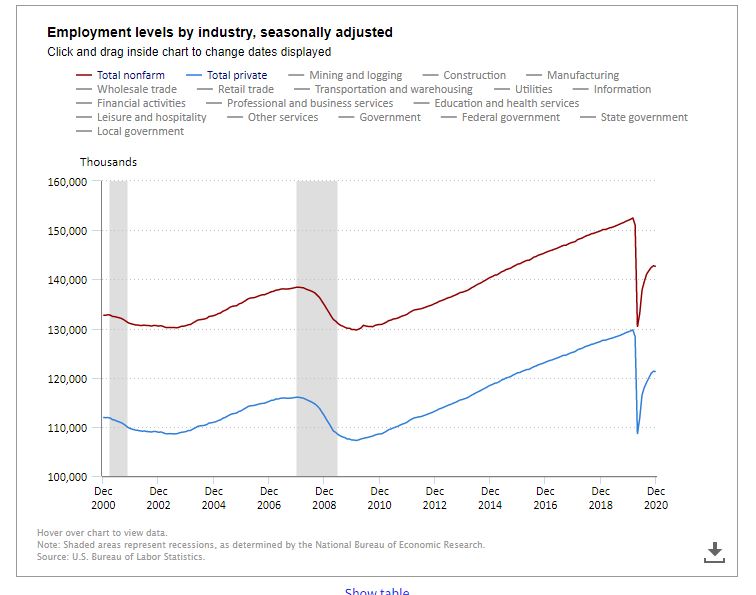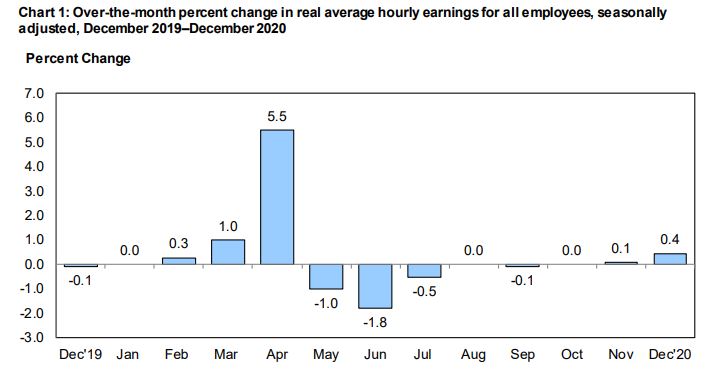Employment Blog January 2021
This employment report is from the U S Department of Labor, Bureau of Labor Statistics. Nonfarm payroll employment declined by 140,000 in December, and the unemployment rate was unchanged at 6.7 percent. The decline in payroll employment reflects the recent rise in the number of coronavirus (COVID-19) cases and increased efforts to contain the pandemic. In December, job losses in leisure and hospitality and in private education were partially offset by gains elsewhere, particularly in professional and business services, retail trade, and construction. Substantial job losses related to the coronavirus pandemic first occurred in March (-1.4 million) and April (-20.8 million) of 2020. As economic activity resumed, employment increased by 12.5 million from May through November. After declining again in December (-140,000), nonfarm employment was below its February level by 9.8 million, or 6.5 percent.


Taking a closer look at the December payroll data, employment in leisure and hospitality decreased by 498,000. Job losses in food services and drinking places (-372,000) accounted for three-quarters of the decline, as many restaurants and bars closed or curtailed operations in December due to the pandemic. Elsewhere in leisure and hospitality, employment decreased by 92,000 in amusements, gambling, and recreation and by 24,000 in accommodation. Since February, employment is down by 3.9 million in leisure and hospitality, including a decline of 2.5 million in food services and drinking places.
Employment in private education declined by 63,000 in December and is down by 450,000 since February.
In December, government employment declined by 45,000. Job losses occurred in state government education (-20,000) and in local government, excluding education (-32,000). Since February, government employment has declined by 1.3 million.
Employment in the other services industry declined by 22,000 in December and is down by 453,000 since February. Within the industry, personal and laundry services lost 12,000 jobs over the month.
Employment in professional and business services rose by 161,000 in December, led by a gain of 68,000 in temporary help services. Computer systems design and related services (+20,000), other professional and technical services (+11,000), management of companies and enterprises (+11,000), and business support services (+7,000) also added jobs over the month. Employment in professional and business services has risen by 1.4 million since a recent low in April but remains 858,000 below its February level.
Retail trade added 121,000 jobs in December, but employment in the industry is down by 411,000 since February. In December, job gains occurred in the component of general merchandise stores that includes warehouse clubs and supercenters (+59,000), in nonstore retailers (+14,000), in automobile dealers (+13,000), and in health and personal care stores (+10,000)
Construction added 51,000 jobs in December, but employment in the industry is down by 226,000 since February. Within the industry, employment grew over the month in residential specialty trade contractors (+14,000) and residential building (+9,000); these residential components have recovered all of the jobs lost in March and April. In December, employment also increased in nonresidential specialty trade contractors (+18,000) and in heavy and civil engineering construction (+15,000).
In December, employment in transportation and warehousing increased by 47,000, mostly in couriers and messengers (+37,000). In addition, job gains occurred in warehousing and storage (+8,000), truck transportation (+7,000), and air transportation (+3,000). Transit and ground passenger transportation lost jobs (-9,000). Employment in transportation and warehousing is down by 89,000 since February; over the same period, employment in the couriers and messengers component has risen by 222,000.
Health care added 39,000 jobs in December. Job gains in hospitals (+32,000) and ambulatory health care services (+21,000) were partially offset by losses in nursing care facilities (-6,000) and community care facilities for the elderly (-5,000). Despite job growth of 1.1 million since April, employment in health care is 502,000 lower than in February.
In December, manufacturing employment increased by 38,000. Within durable goods, job gains occurred in motor vehicles and parts (+7,000) and nonmetallic mineral products (+6,000). In nondurable goods, job gains occurred in plastics and rubber products (+7,000), apparel (+4,000), and petroleum and coal products (+3,000). By contrast, miscellaneous nondurable goods manufacturing lost 11,000 jobs. Employment in manufacturing is down by 543,000 since February.
Wholesale trade added 25,000 jobs over the month, including 11,000 jobs each in durable goods and in nondurable goods. Employment in wholesale trade is down by 251,000 since February.
Employment in other major industries–including mining, information, and financial activities–showed little change over the month.
Real average hourly earnings for all employees increased 0.4 percent from November to December, seasonally adjusted, the U.S. Bureau of Labor Statistics reported today. This result stems from an increase of 0.8 percent in average hourly earnings combined with an increase of 0.4 percent in the Consumer Price Index for All Urban Consumers (CPI-U). Real average weekly earnings increased 0.1 percent over the month due to the change in real average hourly earnings combined with a decrease of 0.3 percent in the average workweek.

